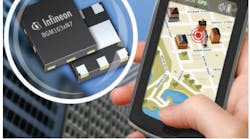All of the modules feature low current consumption to meet mobile-device requirements (4.0 mA/3.1 mA). In cellular bands, they boast out-of-band rejection beyond -43 dBc and a +30- dBm 1-dB input compression point. Each device is rated for 8-kV IEC electro-static discharge (ESD) at the RF input pin. As a result, designers can achieve ESD requirements with only one external component.
In addition, the modules give engineers the flexibility to place any necessary post-filter (single-ended/balanced with suitable noise figure and attenuation) close to the GNSS receiver. To achieve optimized sensitivity, they can place the pre-filter and LNA close to the antenna. Each module features a low-insertion-loss/high-out-of-band-rejection pre-filter followed by a high-performance GNSS LNA.
"Designers are challenged to deliver rock-solid sensitivity performance for location-based serviceseven as GNSS evolves to a series of systems operated by different entities and handheld devices incorporate more high-powered RF technologies, such as Wi-Fi and LTE," explains Michael Mauer, Senior Marketing Director of RF and Protection Devices at Infineon Technologies Mobile Device. That pressure will not soon abate, as iSuppli calculates that 2012 sales of smartphones will reach 450 millionnearly all of which will support GNSS applications.

